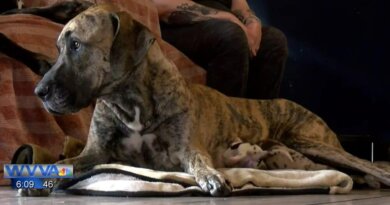How To Adopt A Failed Service Dog
This post may contain affiliate links. We may earn money or products from the companies mentioned in this post.
So you’d like to adopt a failed service dog.
It’s a common question we get at the Puppy In Training blog:
“How can I adopt a retired service dog? or a failed guide dog?” (we like to substitute “career change” for the word “failed”).
I’m not surprised by this question. Not all puppies in training make it as working guide dogs.
Not all service dogs work their entire lives.
And you bet your bottom dollar that these career-change dogs are well-socialized, have great house manners, and are aces in basic obedience.
So it goes without saying that when these dogs are available for adoption, they are in high demand!
QUICK RECOMMENDATION: One of the first things we did before bringing home our first puppy was order and read through Puppies for Dummies. It’s an excellent book that teaches the basics of raising and training a puppy. If you’re considering adopting a puppy then be proactive and start reading about what you can expect.
On today’s agenda:
- I’ll go over a few facts about a career change or a retired service dog.
- I’ve learned a few tips over the years as a puppy raiser on giving yourself the best chance to get a retired service dog.
- Finally, I prepared a list of assistance dog organizations with adoption programs (with direct links to adoption pages).
Career Change Service Dogs
Let’s start off by going over some of the common terms for service dogs that are released from their programs.
- Career Change Service Dogs – because they’re changing careers from service dog to family pet.
- Release Dogs – this is a common term amongst service dog organizations.
- Dream Dogs – One of the programs refers to their adoptable career changes pups as “Dream Dogs”! I like that.
- Very Important Pets (VIP) – Yes, they are!
- Retired Service Dogs – Dublin worked as a guide dog for 6 years and he truly was a “Retired Guide Dog”.
- Companion Dogs – I found at least one site that referred to career changes as companion dogs.
- Furloughed Favorite – At NEADS, a “furloughed favorite” is a dog who, for behavioral, temperamental, or medical reasons, doesn’t meet our strict standards to become a working dog. These dogs are then put up for adoption to the general public.
- Failed Service Dogs – Probably don’t want to call your dog this.
- Drop Outs – or this.
“Career Change Service Dogs” and “Release Dogs” are the most common and probably a bit more P.C. than calling these wonderful animals “Failed Service Dogs”
I have an aunt that adopted a service dog that didn’t make it through the training. Something to keep in mind for readers. It’s a tough process to find the right dogs for these programs and sometimes they just aren’t able to make it.
But these little guys who sadly, fail out of the program, are super smart and need a home. So if you don’t need a service dog but are looking for great little pups who need homes, you can also reach out to these groups to find out where they send the pups that don’t make the cut.
–BB
Service Dog Breeds
If you’re thinking about adopting a Yorkshire Terrier, a Bulldog, or an Irish Wolfhound then it’s highly unlikely you will find what you are looking for when trying to adopt from a service dog organization.
QUICK TIP: As I mentioned the two most common dog breeds in service dog organizations are Golden Retrievers and Labrador Retrievers. Read up on these two breeds to make sure their personality, temperament, and energy level will fit your lifestyle.
While I’m not ruling out that you will never be able to adopt one of these or many other dog breeds at a service dog organization I will say it’s highly unlikely.
Based on our experience here are a few simple facts about what kind of dogs you will find in service dog adoption programs:
Labs and Goldens
Labrador Retrievers and Golden Retrievers are the most common breeds available.
You will also see Lab/Golden crosses as well as German Shepherds, Poodles Labradoodles, and Goldendoodles.
We have seen many other breeds working as service dogs, but these are probably the most common you will see in one of these adoption programs.
The Waitlist Is Long!
Many of these organizations have a very long waiting list for adoptable career change service dogs.
For instance, Guide Dogs of America: “DUE TO THE HIGH DEMAND, OUR WAITLIST IS OVER FIVE YEARS LONG. WE ARE NOT ACCEPTING NEW APPLICATIONS AT THIS TIME.“
Can you recall what you were doing five years ago? Barely. Haha!
Can you imagine what you’ll be doing in five years? Probably not. 🙂
Career Change Service Dogs Are In High Demand
Most programs have more inquiries than adoptable dogs and therefore their selection process is based on suitability rather than a first-come, first-serve basis.
So even with these long waiting lists, you may still receive a dog earlier than anticipated. That’s the good news. The bad news is a lot of these programs are not accepting new applications or they may have a 5+ year waitlist.
Why Are Service Dog Puppies Career-Changed?
Health
Service dogs need to be in perfect health so that they won’t have any issues when helping their partners
Anything from allergies to cataracts to varying severities of dysplasia (hip and elbow).
Behavioral
High activity level, incompatibility with cats or other dogs, assertiveness requiring strong handler leadership.
Some of these dogs may not be suitable for homes with young children or other pets.
5 Tips On How To Adopt A Retired Service Dog
I wanted to know how to adopt a seeing eye dog that has been rejected.
–BR
Okay, guys and gals. Do you still want to adopt a retired service dog?
Do you want to know the best way to facilitate getting said retired service dog?
After 17+ years of raising guide and service dogs, I’ve learned a thing or two about how to give yourself the best chance to adopt a retired service dog.
1. Get involved with the organization
As a puppy raiser, you have the first opportunity to adopt a career-change puppy that you raised.
Stetson was the first puppy I raised and now lives at home with me as a pet.
A friend allowed guide dogs to use his facility for monthly meetings. Several years later he was interested in adopting a career change guide dog. The adoption department bumped his name up the waiting list because of his generosity
2. Find a local service dog organization
After reading through hundreds of service dog websites I’ve found that the majority only adopt out locally.
Check out our Ultimate List of Service Dog Schools with Adoption Programs to find a local school near you.
3. Make a donation
We know a local business that makes yearly donations to guide dogs to sponsor puppies in the guide dog program.
Needless to say, the organization owners have priority anytime they are interested in adopting a career change puppy. I remember one of the owners adopted a beautiful Golden Retriever who was dropped from the program because she chased her shadow.
From The Seeing Eye website: “Highly qualified applicants who make a donation of $25,000 or more to The Seeing Eye may have an adoption expedited process.”
4. Be flexible
I’ve heard through the grapevine that if you are willing to accept a dog with health problems you will have a chance to adopt a retired service dog much quicker.
The severity of health issues can vary from simple skin allergies to severe hip or elbow dysplasia. One of our guide dog puppies was dropped because she had flakey skin. Yes, these programs can be very strict with their guidelines.
Of course, being flexible is not just about accepting a dog with health issues. Expanding your criteria to any breed, sex, color, age, etc. will give you more opportunities to adopt a dog.
5. Keep in touch
Another tip I heard through the grapevine is don’t just send your application in and wait six years.
From the Canine Companions for Independence website: “Applicants will be expected to provide an annual update to their application to maintain their candidacy.”
You really should follow up regularly. I’d even recommend more than once a year. You should get to know the adoption coordinator, development director, puppy program manager, visit the campus, and talk to employees at the school, and puppy raisers.
Keep in touch and stay connected. By keeping in touch you’ll find out when puppies are dropped when dogs are retired, and when a dog becomes available.
The Ultimate List Of Service Dog Schools With Adoption Programs
The ultimate list has arrived!
I sifted through hundreds of service dog organization websites to find the exact adoption page on each site.
UPDATE: Here’s the link to our list of assistance dog schools with adoption programs.
By the way, if you know of an assistance dog school that has an adoption program please let us know so we can update our ultimate list.
So what do you guys think?
Do you have any questions on how to adopt a retired service dog?
Have you already adopted a career-change guide dog?
Tell us about your experiences in the comment section below.
UPDATE: Can you believe we wrote the original article on how to adopt a service dog way back in 2007 (Stetson wasn’t even 1 year old and still a guide dog puppy in training)?
Remember two things:
- Persistence – you need to keep looking and trying.
- Patience – most likely it won’t be a quick process.
Service dogs are well-bred, socialized, and trained. However, you’ll still want to keep up with their training.
If this is your first dog or if you need to brush up on your knowledge and skills I highly recommend reading an introductory book on dog training.
One of our favorites is Puppies for Dummies (I know I already mentioned this book, but it’s worth repeating), a quick and easy read that will give you a solid foundation for your new dog.
And, of course, follow our blog for puppy training tips and tricks.
Best of luck finding your career-changed service dog!
Let us know if you have any questions.
Top Picks For Our Puppies
- BEST PUPPY TOY
We Like: Calmeroos Puppy Toy w/ Heartbeat and Heat Packs – Perfect for new puppies. Helps ease anxiety in their new home. - BEST DOG CHEW
We Like: Mighty Paw Naturals Bully Sticks – All of our puppies love to bite, nip, and chew. We love using Bully Sticks to help divert these unwanted behaviors. - BEST DOG TREATS
We Like: Crazy Dog Train-Me Treats – We use these as our high-value treats for our guide dog puppies. - BEST FRESH DOG FOOD
We Like: The Farmer’s Dog – A couple months ago we started feeding Raven fresh dog food and she loves it! Get 50% off your first order of The Farmer’s Dog.
Check out more of our favorites on our New Puppy Checklist.




